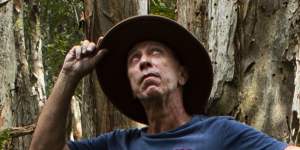The pair,who live in Sydney,purchased the land in 2020 with plans to build a home as a retirement project,and were taken by the region’s beauty.
“It’s all bush and rainforest,and there are massive trees,like 11 metres wide. I thought,‘how bad would it be if it got cleared?’,” Tyrone said.
“The last thing you would want up there would be four-wheel drive tracks,dirt bikes,and empty beer bottles and ciggie butts – it would just ruin the ambience.”

Tyrone Townsend entered a partnership with the NSW Biodiversity Conservation Trust to give his land the same protections as a national park.Sam Mooy
The 100-plus hectare site – roughly the same size as Centennial Park in Sydney – acts as a corridor between Woko National Park and Camel’s Hump Nature Reserve,which are home to endangered koalas,the threatened glossy-black cockatoo and the protected wompoo fruit-dove,a brightly coloured coastal pigeon.
The pair last month entered into a partnership with NSW Biodiversity Conservation Trust,permanently placing the land at the back of the residence under the same protections as a national park.
Nearly 3 per cent of state land is now under these protections since the trust was established in 2017,with more than 2.3 million hectares protected through 2368 private land conservation agreements.
Most landowners negotiate land management payments with the state government. In specific high-priority areas in central and eastern NSW,landholders can enter a fixed price offer,where payments can reach up to $420 per hectare per year.
While the Townsends do not receive ongoing payments as part of the agreement,they can receive grants for specific conservation work.
The protections,and payments,remain even if the land is sold.
NSW Biodiversity Conservation Trust Director Programs Mick O’Flynn said there had been a huge demand for people wanting to join the program.
“We advertise quite widely in a particular region for landholders who have some type of vegetation and ecosystem,” he said.
The department chooses the best option for value and biodiversity,and landowners are partnered with property managers who monitor the area and provide conservation guidance and training.
“They’re making a big commitment that that bit of land will never be cleared or developed,so it’s a really big decision,” O’Flynn said.
The agreements have led to permanent protection for more than 200 threatened species,ranging from lizards to rare orchids.
“It makes the land an asset,with a guaranteed source of income[through management projects],and it’s a really altruistic thing to do,” he said.
A of mammals,frogs,plants and birds were added to the national threatened species list last year,with 144 species – or five times more than the yearly average – now in danger of becoming extinct.
University of Newcastle associate professor of ecology Matthew Hayward said while targeting particular land corridors or micro-ecosystems could have major benefits,there was a problem with “biodiversity offsetting”.
“We’re trying to use economics to buy our way out of the conversation and biodiversity crisis,[but] we’re ignoring the costs associated with developing land and impacting biodiversity,” he said.
“We need to somehow cost into our economical way of existence,the impact or the costs associated with climate change,but also with the biodiversity crisis.”
The Invasive Species Council estimates Australia has been averaging at least 4.5 probable extinctions every decade since the 1960s.
Get to the heart of what’s happening with climate change and the environment.